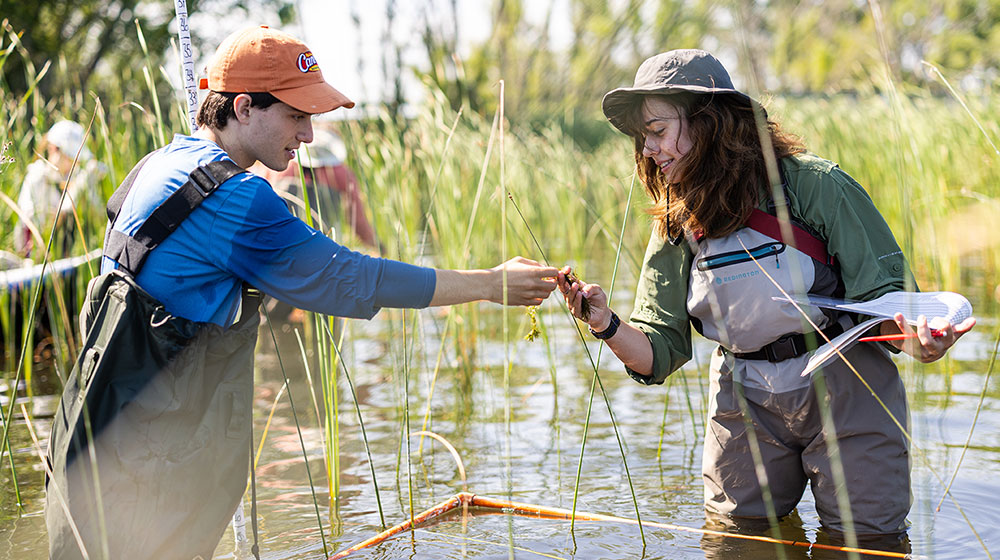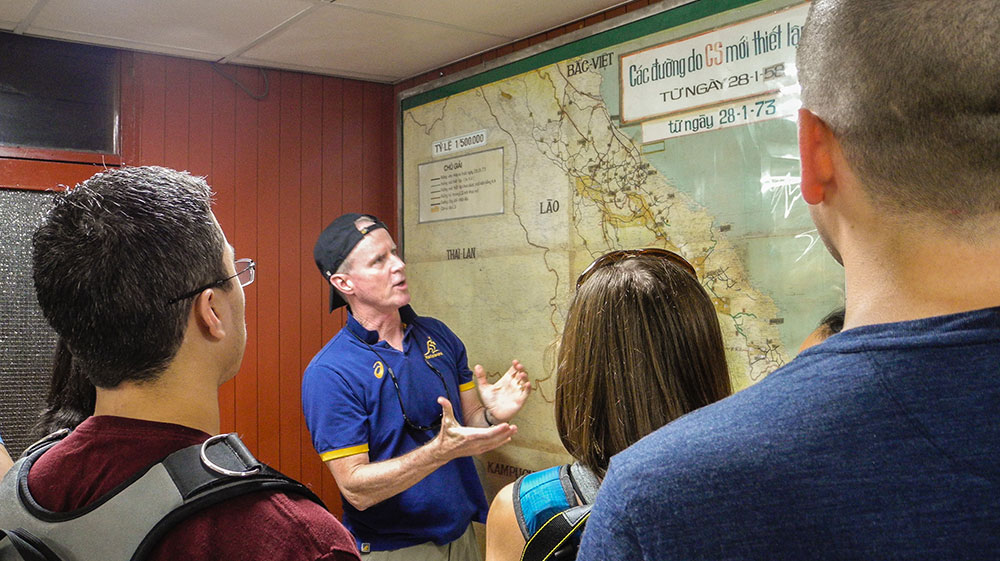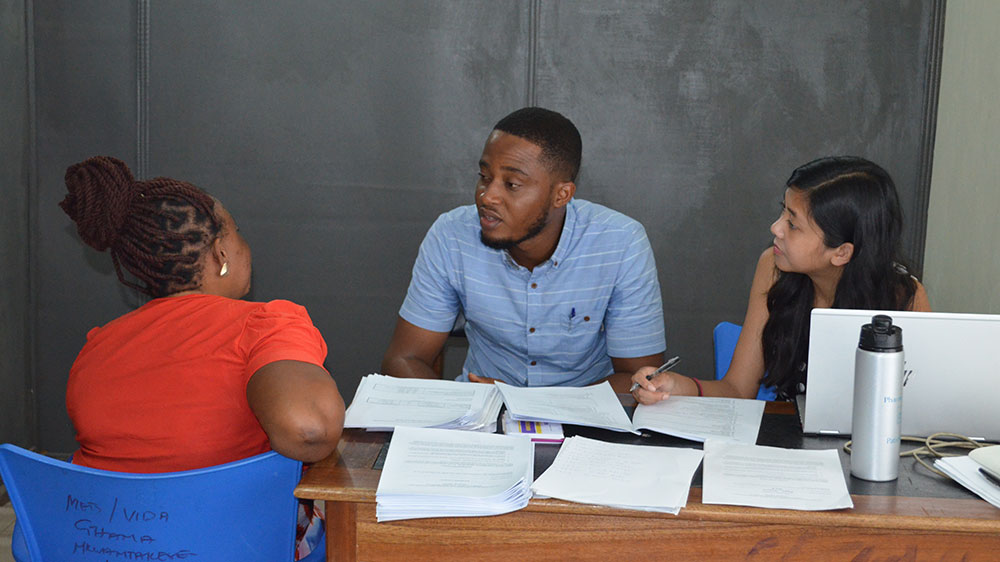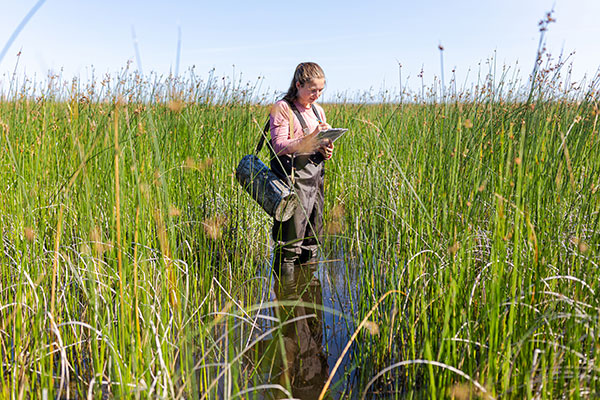Story - SES - Team Typha

Loyola students and researchers conduct field research on native and invasive cattail plants in Lake Huron as part of a partnership with the University of Michigan Biology Station in Pellston, MI., PHOTO BY LUKAS KEAPPROTH
Training the Next Generation of Scientists in the Wetlands
Team Typha members get hands-on experience
For Brian Ohsowski, an assistant professor at Loyola’s School of Environmental Sustainability (SES), there are few better moments than watching a student don waders for the first time, walk into a wetland and immediately realize something was missing from their life.
“I’m focused on training our students to become good scientists,” he said. “It’s motivating and enriching to see our students understand nature through scientific discovery and curiosity.”
Ohsowski leads Team Typha, a research group that works to combat invasive plants that disrupt wetland ecosystems, with research associate Shane Lishawa. Their work has two overlapping core missions: to explore ways to limit the harm Typha, a highly invasive emergent marsh plant, does to wetlands, and to train the next generation of scientists.
Novel Approach to Combatting an Invasive Species
Ohsowski and Lishawa recently received a prestigious $1.1 million grant from the federal government’s Great Lakes Restoration Initiative (GLRI). This funding enables the group to investigate the use of an innovative method to control Typha, which would otherwise crowd out native plants and animals in impacted wetland ecosystems. Their work is being conducted in the Shiawassee National Wildlife Refuge, located in Central Michigan.
Ohsowski, Lishawa, and Loyola undergraduate and graduate students collect invasive Typha with a wetland harvester similar to a thresher. Lishawa’s previous work confirms harvesting effectively reduces Typha dominance in field experiments. The researchers are now addressing the collected biomass by converting it into biochar, a kind of charcoal. Biochar is known to chemically bind vital plant nutrients such as nitrates and phosphates—a quality that could be valuable for reducing the spread of Typha invasions. While Typha thrives in nutrient-rich environments, native species are adapted to growing in lower-nutrient conditions. The scientists are hypothesizing that by introducing biochar to absorb some of the nutrients that Typha hogs, the native species will be better able to compete.
“We’re trying to use invasive cattail to slow the growth of invasive cattail,” Ohsowski said. “It's experimental, but it's very promising so far.”
Kristina Tsakos, a member of the Class of 2023, won a Society of Wetland Scientists Student Research Grant to support her work with Typha. “The study of biochar is still in its infancy," she said. "We see its effects, but we don’t really know why these things happen yet. That’s what I am trying to figure out with this research.”

Loyola University Chicago
The Pursuit of Purpose
What can be learned from Loyola’s 153-year track record on social impact
Read the story
Quinlan School of Business
From Chicago to Southeast Asia
Experiential Learning Makes its Mark on Business Students
Read the story
Parkinson School of Health Sciences and Public Health
Scientific Impact
Long-term study on African diaspora continues to challenge public health beliefs
Read the story
Loyola students and researchers conduct field research in Cecil Bay as part of a partnership with the University of Michigan. - PHOTO BY LUKAS KEAPPROTH
Students find their purpose
Each year, a handful of undergraduate students participate in a year-long wetlands research project with Ohsowski and Lishawa. The students work as technicians helping to collect data for several grant-funded research projects, and in the process learn how to identify plants, analyze samples, and share results.ng
The majority of students also receive funding from the Loyola Undergraduate Research Opportunity Program to support individual research projects.
“Being surrounded by people who also care about things I’m interested in and being out in nature was wonderful. Being knee-deep in mud every day was fun, and getting closer to my team was a life-changing experience,” Tsakos said.
After seven weeks of summer field work, students return to the lab to continue developing and executing their own research projects during the academic year.
“They're technicians. They're students. They do it all,” Ohsowski said. Several undergraduate students have finished their degrees having co-written a scientific publication—a feat Ohsowski called “a rare opportunity”—and often go on to earn advanced degrees in the sciences.
These outcomes can be a surprise to the students, who don’t start college expecting to become wetlands experts.
“We walk students into a wetland for the first time, and many of them leave Loyola saying, ‘This is my life’s work,’” Brian Ohsowski, assistant professor at Loyola’s School of Environmental Sustainability
Even students who decide a life of wading through the muck in the sun isn’t for them are affected by seeing how science can be applied to real world problems. Former Team Typha members are now working at the U.S. Forest Service, teaching high school and college, and completing cutting-edge carbon modeling projects. They’re solving today’s problems—and preparing to tackle the challenges of the future.
For Ohsowski, it’s the best part of the job.
“I love being at an institution like Loyola where teaching and student development are prioritized. I have the flexibility to personally work with undergrads. It's the most rewarding thing,” he said.

Loyola students and researchers conduct field research in Cecil Bay as part of a partnership with the University of Michigan. - PHOTO BY LUKAS KEAPPROTH
Students find their purpose
Each year, a handful of undergraduate students participate in a year-long wetlands research project with Ohsowski and Lishawa. The students work as technicians helping to collect data for several grant-funded research projects, and in the process learn how to identify plants, analyze samples, and share results.ng
The majority of students also receive funding from the Loyola Undergraduate Research Opportunity Program to support individual research projects.
“Being surrounded by people who also care about things I’m interested in and being out in nature was wonderful. Being knee-deep in mud every day was fun, and getting closer to my team was a life-changing experience,” Tsakos said.
After seven weeks of summer field work, students return to the lab to continue developing and executing their own research projects during the academic year.
“They're technicians. They're students. They do it all,” Ohsowski said. Several undergraduate students have finished their degrees having co-written a scientific publication—a feat Ohsowski called “a rare opportunity”—and often go on to earn advanced degrees in the sciences.
These outcomes can be a surprise to the students, who don’t start college expecting to become wetlands experts.
“We walk students into a wetland for the first time, and many of them leave Loyola saying, ‘This is my life’s work,’” Brian Ohsowski, assistant professor at Loyola’s School of Environmental Sustainability
Even students who decide a life of wading through the muck in the sun isn’t for them are affected by seeing how science can be applied to real world problems. Former Team Typha members are now working at the U.S. Forest Service, teaching high school and college, and completing cutting-edge carbon modeling projects. They’re solving today’s problems—and preparing to tackle the challenges of the future.
For Ohsowski, it’s the best part of the job.
“I love being at an institution like Loyola where teaching and student development are prioritized. I have the flexibility to personally work with undergrads. It's the most rewarding thing,” he said.
